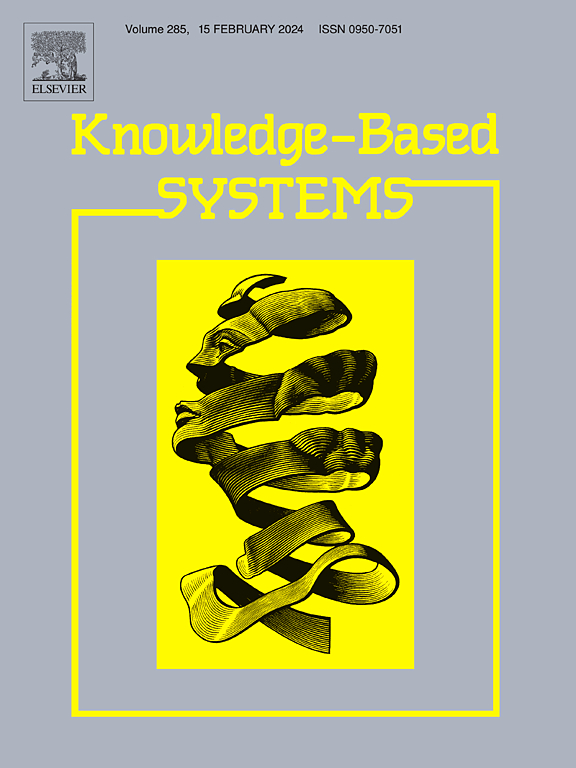SDVD: Self-supervised dual-view modeling of user and cascade dynamics for information diffusion prediction
IF 7.2
1区 计算机科学
Q1 COMPUTER SCIENCE, ARTIFICIAL INTELLIGENCE
引用次数: 0
Abstract
Information diffusion prediction aims to estimate the likelihood of a user participating in a spreading message by leveraging social relationships and historical diffusion patterns. However, existing approaches often overlook a crucial factor: users’ participation behaviors are influenced by diverse and evolving motivations. Moreover, treating historical data as a whole may introduce noise from outdated information — especially as new users join — highlighting the dynamic nature of diffusion cascades. In addition, many current methods lack explicit supervision signals to effectively model these dynamics. To address these limitations, we propose SDVD, a novel framework for Self-supervised Dual-View modeling of user and cascade Dynamics for information diffusion prediction. SDVD begins by constructing two auxiliary graphs from historical data: an adjacency dependency graph to capture temporal dependencies and a hypergraph to model group interactions. These structures explicitly model cascade dynamics and enhance user–cascade interaction understanding. We leverage graph neural networks and hypergraph neural networks to extract structural features from the graphs and introduce a user-aware fusion mechanism that integrates multisource information while reducing redundancy and noise. Furthermore, we design a self-supervised dual-view dynamic modeling module to learn temporal variations in diffusion patterns from both user and cascade perspectives. A cross-attention mechanism then combines static and dynamic representations, capturing contextual information within the cascade sequence. Experiments on four real-world datasets — with consistent preprocessing and data splitting — show that SDVD achieves statistically significant improvements (), with up to a 6.63% increase in MAP@10.
信息扩散预测的用户和级联动力学自监督双视图建模
信息扩散预测旨在通过利用社会关系和历史扩散模式来估计用户参与传播信息的可能性。然而,现有的方法往往忽略了一个关键因素:用户的参与行为受到多种多样和不断发展的动机的影响。此外,将历史数据作为一个整体来处理,可能会引入过时信息带来的噪音——尤其是在新用户加入的情况下——突显扩散级联的动态性质。此外,许多现有的方法缺乏明确的监督信号来有效地模拟这些动态。为了解决这些限制,我们提出了SDVD,这是一个用于信息扩散预测的用户和级联动力学的自监督双视图建模的新框架。SDVD首先从历史数据构建两个辅助图:一个邻接依赖图用于捕获时间依赖关系,一个超图用于模拟组之间的相互作用。这些结构明确地模拟级联动力学和增强用户级联交互的理解。我们利用图神经网络和超图神经网络从图中提取结构特征,并引入用户感知融合机制,在减少冗余和噪声的同时集成多源信息。此外,我们设计了一个自监督双视图动态建模模块,从用户和级联的角度学习扩散模式的时间变化。然后,交叉注意机制将静态和动态表示结合起来,在级联序列中捕获上下文信息。在四个真实数据集上的实验-具有一致的预处理和数据分割-表明SDVD实现了统计学上显著的改进(p<0.05), MAP@10的增幅高达6.63%。
本文章由计算机程序翻译,如有差异,请以英文原文为准。
求助全文
约1分钟内获得全文
求助全文
来源期刊

Knowledge-Based Systems
工程技术-计算机:人工智能
CiteScore
14.80
自引率
12.50%
发文量
1245
审稿时长
7.8 months
期刊介绍:
Knowledge-Based Systems, an international and interdisciplinary journal in artificial intelligence, publishes original, innovative, and creative research results in the field. It focuses on knowledge-based and other artificial intelligence techniques-based systems. The journal aims to support human prediction and decision-making through data science and computation techniques, provide a balanced coverage of theory and practical study, and encourage the development and implementation of knowledge-based intelligence models, methods, systems, and software tools. Applications in business, government, education, engineering, and healthcare are emphasized.
 求助内容:
求助内容: 应助结果提醒方式:
应助结果提醒方式:


